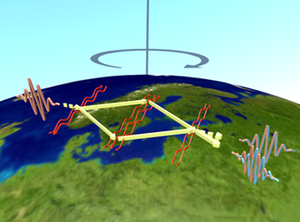A Better Quantum Gyroscope
An improved design for a rotation-measuring device based on cold atom clouds has twice the sensitivity of similar instruments and could, with further refinements, be among the best in the world, say its creators. The device is an atom interferometer, an instrument that makes use of the wave nature of atoms, and a team used it to measure the Earth’s rotation with an accuracy of about 1%. They say that because atom interferometers can be made small and portable, future versions could be used in extremely sensitive and stable gyroscopes for navigation onboard airplanes and ships. They could also make precise measurements of gravity and test the fundamentals of relativity theory.
Researchers have used atom interferometers for precision measurements of gravity and rotation. Improvements in the technology could be useful for measuring continental drift rates and seismic shifts as well as providing an external check and backup to navigational technology such as GPS. The most accurate measurements of the Earth’s rotation come from large machines, but cold atom interferometers promise highly precise yet portable devices.
The classical interferometer uses light waves. For example, in a Mach-Zehnder interferometer, a half-silvered mirror (“beam splitter”) splits a pulse of light in two and sends the beams in different directions. The pulses then hit other mirrors that direct them back toward one another, and they recombine at a second beam splitter, where the output light is detected. The two beams trace out a diamond shape, with each pulse following two sides. If one of the beams traveled slightly farther than the other, the waves in the two beams will be slightly out of phase when they meet, and they will partially cancel. The sensitivity of an interferometer depends on the wavelength, so researchers dramatically improve precision by using atoms, whose quantum nature produces much shorter wavelengths.
In one version of an atom interferometer, a cloud of cold atoms is launched horizontally and is hit with a series of three laser pulses as it traverses the region being probed. The laser pulses play the roles of the mirrors and the two beam splitters of an optical interferometer. The first pulse puts the atoms into a quantum combination of two conditions—(1) deflecting to the left in the ground state and (2) deflecting to the right in an excited state. The second pulse deflects the two clouds back toward each other and swaps their quantum states, and the third combines the clouds in preparation for measurement of the number of atoms in the excited state. In an atom interferometer, the wave is an oscillating probability for atoms to be in this excited state, rather than an oscillating electric field, as in an optical interferometer. Because the Earth rotates, one of the clouds will travel slightly farther than the other, which will cause a partial cancellation of the probability waves and will affect the number of atoms measured at the end.
One major source of error for previous atom interferometers was that the two clouds travel a relatively long distance while in different quantum states (ground and excited states). Outside forces, particularly magnetic fields, can affect the two clouds differently, introducing uncertainty (noise) into the measurement. A team led by Ernst Rasel of the Leibniz University of Hannover, Germany, was able to reduce this noise by arranging for both clouds to be in the ground state for most of the experiment, so that the two clouds were affected by outside forces in the same way. The team used multiple laser pulses at each of the three interaction points and generated only brief transitions between the two states.
Based on their measurement of the Earth’s rotation rate to an accuracy of 1%, the team says their technique is twice as sensitive as state-of-the-art, cold-atom gyroscopes. They believe they can increase their sensitivity by at least ten times, equaling the best gyroscopes currently operating, but using an area of just 40mm2, compared with the 16m2 needed for the most sensitive gyroscopes. Hannover team member Peter Berg says the same technique could also improve experiments where a vertically oriented interferometer tests the equivalence of gravitational and inertial forces, a central principle of relativity. Holger Müller, of the University of California, Berkeley, says that by reducing one of the leading causes of error in atom interferometers, this type of work can help bring the technology out of the lab and into more general use.
This research is published in Physical Review Letters.
–Adam Mann
Adam Mann is a freelance science writer in Oakland, California.





